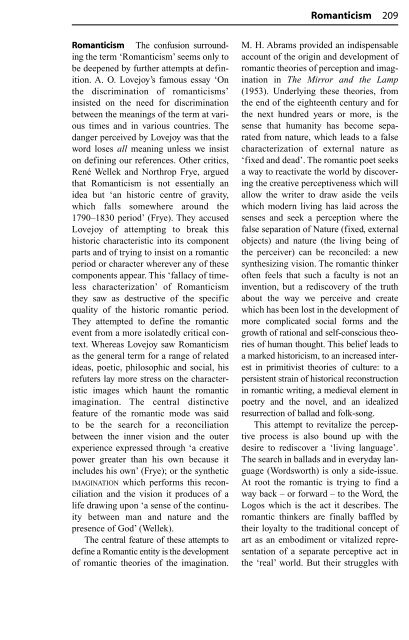The Routledge Dictionary of Literary Terms
The Routledge Dictionary of Literary Terms
The Routledge Dictionary of Literary Terms
Create successful ePaper yourself
Turn your PDF publications into a flip-book with our unique Google optimized e-Paper software.
Romanticism <strong>The</strong> confusion surrounding<br />
the term ‘Romanticism’ seems only to<br />
be deepened by further attempts at definition.<br />
A. O. Lovejoy’s famous essay ‘On<br />
the discrimination <strong>of</strong> romanticisms’<br />
insisted on the need for discrimination<br />
between the meanings <strong>of</strong> the term at various<br />
times and in various countries. <strong>The</strong><br />
danger perceived by Lovejoy was that the<br />
word loses all meaning unless we insist<br />
on defining our references. Other critics,<br />
René Wellek and Northrop Frye, argued<br />
that Romanticism is not essentially an<br />
idea but ‘an historic centre <strong>of</strong> gravity,<br />
which falls somewhere around the<br />
1790–1830 period’ (Frye). <strong>The</strong>y accused<br />
Lovejoy <strong>of</strong> attempting to break this<br />
historic characteristic into its component<br />
parts and <strong>of</strong> trying to insist on a romantic<br />
period or character wherever any <strong>of</strong> these<br />
components appear. This ‘fallacy <strong>of</strong> timeless<br />
characterization’ <strong>of</strong> Romanticism<br />
they saw as destructive <strong>of</strong> the specific<br />
quality <strong>of</strong> the historic romantic period.<br />
<strong>The</strong>y attempted to define the romantic<br />
event from a more isolatedly critical context.<br />
Whereas Lovejoy saw Romanticism<br />
as the general term for a range <strong>of</strong> related<br />
ideas, poetic, philosophic and social, his<br />
refuters lay more stress on the characteristic<br />
images which haunt the romantic<br />
imagination. <strong>The</strong> central distinctive<br />
feature <strong>of</strong> the romantic mode was said<br />
to be the search for a reconciliation<br />
between the inner vision and the outer<br />
experience expressed through ‘a creative<br />
power greater than his own because it<br />
includes his own’ (Frye); or the synthetic<br />
IMAGINATION which performs this reconciliation<br />
and the vision it produces <strong>of</strong> a<br />
life drawing upon ‘a sense <strong>of</strong> the continuity<br />
between man and nature and the<br />
presence <strong>of</strong> God’ (Wellek).<br />
<strong>The</strong> central feature <strong>of</strong> these attempts to<br />
define a Romantic entity is the development<br />
<strong>of</strong> romantic theories <strong>of</strong> the imagination.<br />
Romanticism 209<br />
M. H. Abrams provided an indispensable<br />
account <strong>of</strong> the origin and development <strong>of</strong><br />
romantic theories <strong>of</strong> perception and imagination<br />
in <strong>The</strong> Mirror and the Lamp<br />
(1953). Underlying these theories, from<br />
the end <strong>of</strong> the eighteenth century and for<br />
the next hundred years or more, is the<br />
sense that humanity has become separated<br />
from nature, which leads to a false<br />
characterization <strong>of</strong> external nature as<br />
‘fixed and dead’. <strong>The</strong> romantic poet seeks<br />
a way to reactivate the world by discovering<br />
the creative perceptiveness which will<br />
allow the writer to draw aside the veils<br />
which modern living has laid across the<br />
senses and seek a perception where the<br />
false separation <strong>of</strong> Nature (fixed, external<br />
objects) and nature (the living being <strong>of</strong><br />
the perceiver) can be reconciled: a new<br />
synthesizing vision. <strong>The</strong> romantic thinker<br />
<strong>of</strong>ten feels that such a faculty is not an<br />
invention, but a rediscovery <strong>of</strong> the truth<br />
about the way we perceive and create<br />
which has been lost in the development <strong>of</strong><br />
more complicated social forms and the<br />
growth <strong>of</strong> rational and self-conscious theories<br />
<strong>of</strong> human thought. This belief leads to<br />
a marked historicism, to an increased interest<br />
in primitivist theories <strong>of</strong> culture: to a<br />
persistent strain <strong>of</strong> historical reconstruction<br />
in romantic writing, a medieval element in<br />
poetry and the novel, and an idealized<br />
resurrection <strong>of</strong> ballad and folk-song.<br />
This attempt to revitalize the perceptive<br />
process is also bound up with the<br />
desire to rediscover a ‘living language’.<br />
<strong>The</strong> search in ballads and in everyday language<br />
(Wordsworth) is only a side-issue.<br />
At root the romantic is trying to find a<br />
way back – or forward – to the Word, the<br />
Logos which is the act it describes. <strong>The</strong><br />
romantic thinkers are finally baffled by<br />
their loyalty to the traditional concept <strong>of</strong><br />
art as an embodiment or vitalized representation<br />
<strong>of</strong> a separate perceptive act in<br />
the ‘real’ world. But their struggles with

















